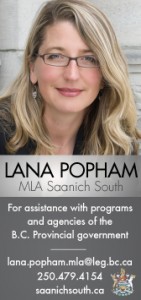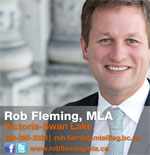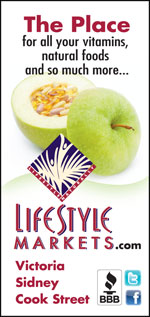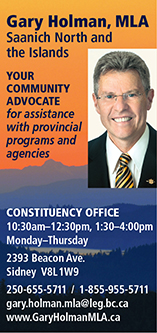Archive for December 2014
Saanich will be looking for a new CAO, as of yesterday
Media Release
For Immediate Release December 17, 2014
Staff Announcement – Mr. Paul Murray
Saanich, BC – The newly elected Mayor and Council of the District of Saanich together with the District’s Chief Administrative Officer have mutually agreed to end their relationship effective December 16, 2014. As this decision involves confidential information regarding personnel, no further comment will be made. The District thanks Mr. Murray for his service, and wishes him every success in his future endeavours.
At the December 8, 2014 in-camera Council Meeting the following motion was supported unanimously by Councillors:
“That Council does not support actions taken by Mayor Richard Atwell, whether as Mayor-elect or Mayor, with respect to the ongoing employment of Paul Murray as Chief Administrative Officer of the District of Saanich.”
This in-camera meeting was the first opportunity for the entire Council to discuss Mayor Atwell’s actions regarding the employment of Mr. Murray. Council through the above motion raised its concern and objection to the activities and the process that was undertaken by the Mayor without knowledge or agreement of Council. The actions taken by Mayor Atwell left Council with no viable options other than to proceed to end the employment relationship with Mr. Murray. Council is also concerned about the financial impact the Mayors’ actions have had on the citizens of Saanich – a total payment of $476,611 (inclusive of accrued vacation of $55,448). This equates to 0.50% of taxation money that cannot be used for other initiatives of the municipality.
-30-
""
Saanich News has Mayor Atwell’s response to the events:
“It was a very short conversation done in my office. I invited him in for a discussion about moving on and that started the proess of him thinking about leaving. Council looked at it and decided they would negotiate his departure,” Atwell said.
“Where council has difficulty is I made this initial contact with Mr. Murray as Mayor-elect, and I think they expected that to come to council first,” he said.
Atwell said the $476,000 severance package will be paid out of several funds, but couldn’t immediately provide specifics.
“$55,000 of that is accrued vacation,” Atwell said. “There doesn’t seem to be a limit to how much vacation a senior manager can accrue.”
When asked about the unanimous councillor motion opposing his actions, Atwell said he sees himself in an oversight role within the municipality, and that voters gave him a mandate for change at the ballot box.
“That means getting new ideas into the organization. A new CAO will be able to implement some of those ideas that I campaigned on.
“There will be councillors interested in maintaining the status quo … but change is often difficult and there are costs to moving forward,” he said.
SN’s full article can be found here:
http://www.saanichnews.com/news/286112831.html
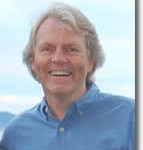
AMALGAMATION – where do we go from here?
Michael J. Prince is the Lansdowne Professor of Social Policy at the University of Victoria. A political scientist, he follows local, provincial and federal politics and governments.
The question of amalgamation in the Capital Region is a contentious and complex topic with no straightforward or guaranteed answers. In Saanich and on the Saanich Peninsula two very different next steps seem likely to play out over the next four years.
In Saanich, the non-binding referendum questions were not directly about amalgamation, as they were in other CRD municipalities; no mention here of asking for a provincial government funded study or on reducing the number of municipalities in Greater Victoria.
Rather, Saanich voters were asked if they would support their Council initiating a community-based review of the governance structure and policies within Saanich and on partnerships within the Region.
On that question, 88.5 percent of Saanich voters said yes. This can be interpreted in several ways: as widespread support for making the civic governance of Saanich more transparent and open to the public, as expressed by the mayor-elect, Richard Atwell; as modernizing policies; as adopting best practices for service delivery; and, perhaps, examining options for sharing some services through partnerships with other municipalities in the Region. None of these imply amalgamation. As the largest municipality in Greater Victoria, there is little incentive for Saanich leaders or residents to rush into amalgamation. (In Esquimalt, 86.6 percent of voters supported the idea of sharing some services with other municipalities; when asked about reducing the number of municipalities in the region, support was lower, yet still substantial at 67.4 percent.)
After the November 15th local elections, a different future for civic government seems probable on the Saanich Peninsula.
""
In comparison to referendum questions on amalgamation presented to voters in Esquimalt, Langford, Oak Bay, and Victoria, the questions on the Peninsula presented a specific scenario of what amalgamation might mean as regards to the basic process of a study and the actual number of municipalities involved.
Voters in the District of North Saanich and in the Town of Sidney were asked a near identical question: are you in favour of a study, provincially funded, to investigate the feasibility, costs and implications of amalgamating the three municipalities on the Saanich Peninsula? In Central Saanich, the question was quite similar in nature: should the District petition the Province to fund a cost/benefit analysis of an amalgamation of Central Saanich, North Saanich and Sidney?
In North Saanich, 62.5 percent of voters supported the idea of such a study on assessing the costs and benefits of amalgamating the three municipalities; in Sidney, 67.5 percent of voters expressed agreement; and, in Central Saanich, 70.6 percent of voters on the questions indicated their support.
In all three of these municipalities, it is worth adding, nearly all voters (96 to 99 percent) who cast ballots for mayoral and council candidates, also voted on the referendum question. This suggests that the question of amalgamation was taken seriously by voters and not treated as some frivolous or minor issue.
The similarity of the questions and the evidence of strong support by voters in Central Saanich, North Saanich and Sidney provide a solid democratic basis for a provincially funded study on the benefits, costs and implications of amalgamating the three municipalities on the Saanich Peninsula.
Following a provincially commissioned study, this could mean that at the next local elections in October 2018, there could be a binding referendum question on the Saanich Peninsula. As a result, we could go from 13 to 11 municipalities in the Region by 2020. This appears the most likely political outcome on amalgamation over the medium term; disappointing results for those eager for more drastic and rapid change in the local governance of Greater Victoria.
Beyond that, the amalgamation issue seems destined to the back burner or to a sewage treatment plant.
SVO Arts Scene – Caleb Speller – on collage
by Judy Barlow
Every artist has his or her own creative process. Rising star Caleb Speller’s is a little different from others – in that he’s never quite sure what the day will bring.
“What I try to do with my artwork,” says Caleb, “is explore different themes. I don’t think in the morning, ‘I’m going to spend some time with a piece of paper and just draw.’ I’ll ask myself what materials will best describe the theme for the viewer. It usually comes to me while I’m working on it.”
It takes a lot of trust in the process to throw an idea up in the air and see if it flies. Caleb’s confidence comes from an unshakeable belief that his creativity is a gift from God.
“I’m looking at life as a gift and I’m looking at the skills God has given me and I’m wondering every day, ‘What can I do with these skills that I haven’t done yet?’ I want to understand why God has given me this gift.”
A collage artist makes use of old magazines, catalogues and books; maybe even garbage off the street and repurposes the material. Sometimes it’s meant to trigger a dialogue; other times it’s meant to give a totally different representation of what something used to be. In our affluent society, Caleb notes. “There are so many free resources at our fingertips that you can be creative on a dime. You don’t need to go to the art store and pay for an expensive piece of French paper. It’s so basic and free from the financial aspect of creativity.”
Caleb’s hugely successful collage project, Public Domain, was extracted entirely from renowned Canadian photographer Yousef Karsh’s portraits of famous people. “The paper quality is perfect for a collage artist to borrow from on a material level, even without the visuals. I extracted from his portraits and the achievements that those people were known for, and repurposed them to a new history within 15 collages. So if you wanted to research this project you can find every little piece of the new collages in those portfolios.”
“When something dies [its] energy goes into something else. When someone’s done with something, even a simple magazine, we say it’s going in the trash or the recycling. It just means that it’s going away from us; it’s not going away. Collage has that dialogue embedded within it – you’re taking back something that was moved away from someone else and bringing it back into focus.”
Caleb enjoys breathing new life into society’s detritus. “I think art always has that quality – we’re always turning something into something else.”
Caleb’s work has received both national and international attention. Look for new ceramic designs in Wishlist 6, the group exhibition opening December 4th at Polychrome Fine Art. His wildly popular Food Stamps exhibit was showcased at both Lady Marmalade Café’s Victoria location and their Toronto one in October.
An upcoming collaboration with Shawn Grocott from Shawn and the Wolf, a jazz duo, finds the pair developing a German exhibit in 2015.
Caleb’s very limited book, Artwork by Caleb Speller is available online. Or you can purchase one of his unique refurbished bicycles, accompanied by a custom-designed Caleb Speller tag. And he’s collaborating with the locally based Toy and Ming on a limited clothing line of wearable art fashioned from custom-printed fabric full of Caleb Speller’s drawings.
So what is it that drives this young man to get up and create something new every day?
“As artists we want people to come and see our artwork …” says Caleb. “We want to be able to have at least enough of a description of what it is and why it is – it’s more than just a piece of art – it’s a conversation attached with it. There’s a deeper aspect of my creativity that I’m aware of, but I can’t fully describe yet. But I know it’s a gift – every moment is. It’s something I don’t want to take for granted. If you have knowledge or a skill and you keep it to yourself you’re being selfish – it’s not going to grow and it’s not going to be of use to anybody.”
Keep your eye on Caleb Speller. He’s growing and going places – and not just geographically. Someday you’ll say, “I knew him when…”
calebspeller.yolasite.com | polychromefinearts.co
Psych Test , Colour Sheet Number Five – 2014 By Caleb Speller, Collage on black paper, 76 X 57cms
Gifting from the Heart
The giving season is upon us and it can mean all sorts of things to all sorts of people.
For retail merchants the giving season often represents the time of the year that their books start to show evidence that their hard work all year will pay off. For charities it represents the time of year that people feel, and act most philanthropic. For everyone else it can be a stressful time of balancing the budget, their values around commercialism and over-consumption, and their desire to show their friends and family that they care by
giving them a token of their love and appreciation.
What if you were able to do good – by shopping?
In this day of local, fair trade and ethical shopping, we can make all sorts of choices about how we use our gift dollars to do good.
If supporting the resiliency and sustainability of your community is important to you, or the person you are gifting to, then just choosing a local merchant, service provider or product over a non-local business can make a huge difference.
Michael Shuman, economist, attorney, prolific author and instructor of the course ‘LocaNomics: Principles and Practice for Community Prosperity’ in SFU’s Community Economic Development program says, “For every dollar that you spend at a local shop you get two to four times the economic impact that you would had you shopped just at its non-local competitor.”
Shuman references a study out of the US that showed for every $100 spent at a local bookstore, $43 stayed in the local economy, compared to only $13 when the same $100 was spent at a chain bookstore. These stats have proven consistent in over a dozen studies done both inside and out of the US.
Shuman says that the difference between local and non-local merchants, and how one better supports the local economy, is partly explained by where the company’s head office is. “Chain-stores don’t have upper management here; their lawyers and accountants are not here and the chain-stores don’t advertise in local media.”
Are Chapters executives having dinner in Sidney tonight, or buying their Girl Guide cookies from your daughter? Are their lawyers buying their holiday turkeys from Carnivore Meats & More, (whose owner buys many of his turkeys from Ireland Farms, and whose bookkeeper lives just down the road…).
The idea of supporting charities or causes through product purchases is nothing new. World Aids Day sees Apple selling red iPods in support of the cause while New Balance offers you the option of ‘lacing up for the [breast cancer] cure,’ through the purchase of their rose-coloured sneakers. Of course the Girl Guides have been easing our cookie splurging guilt since 1927.
Used Victoria has started a new service that benefits shoppers, local charities and de-clutterers alike. People are invited to list treasures that they are ready to part with, but instead of taking the money themselves, they elect to offer the money to the charity of their choice. Local charities are registered on the site and unlike a regular sale on Used Victoria, the money exchange is done online via credit cards. For more information see #UsedHelps on UsedVictoria.com.
If fair trade that supports families in distant lands interests you, then Sidney’s Laloca is certainly worth a visit. Tucked away in the alley at Garden Court off Beacon Avenue, this little shop is chock full of treasures from both near and far. Shop owner Christine Downing says, “Laloca is dedicated to building sustainable livelihoods for people both locally and across the world.”
Saanich Voice Online invites you to support our local merchants this giving season, because it’s a great thing to do – and because they support local media.


